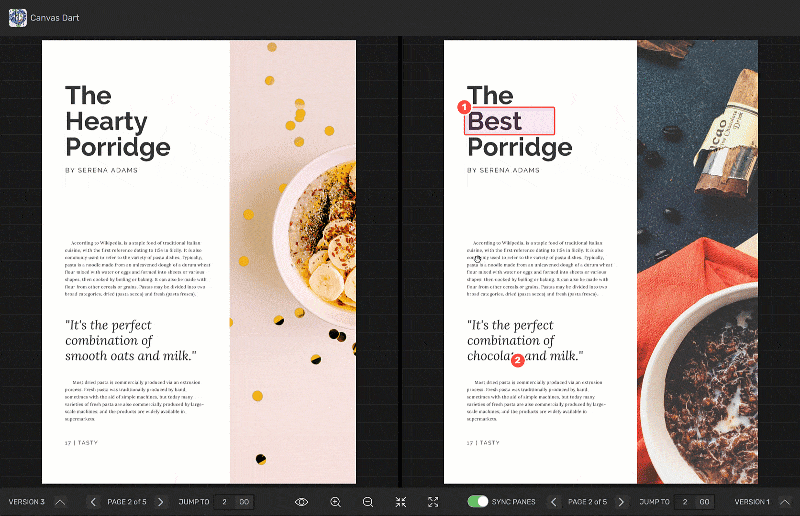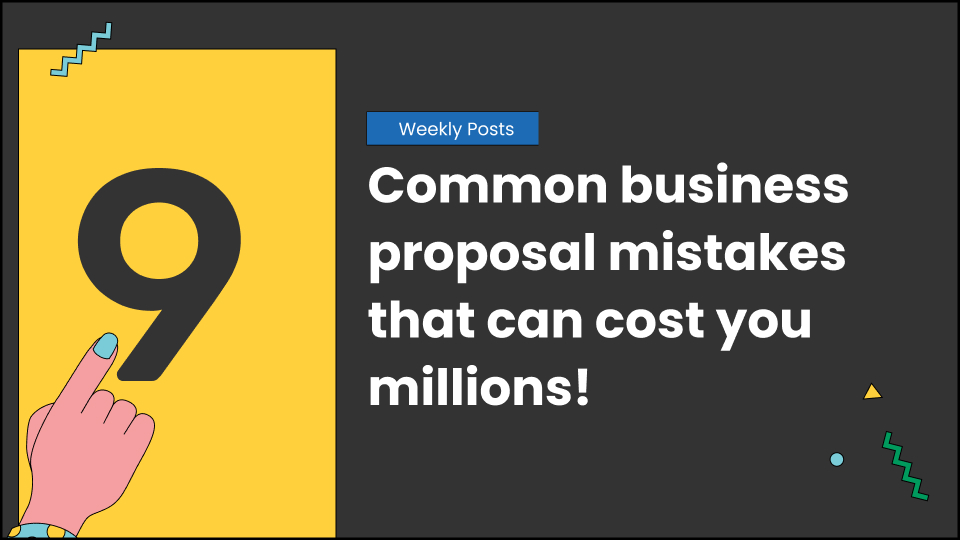It’s a tough market out there when you’re trying to sell your services. That means getting business proposal mistakes out of the way.
Business proposals are, in many ways, the lifeblood of an organization. If a proposal is rejected, it might not be easy to forge new relationships with creative agencies. Or worse yet, it might lead to the company’s failure and takeover.
Whether new to the game or want to ensure that your work is top-quality, people often make several common mistakes when writing a business proposal.
These mistakes can cost you either a potential client or a deal – so read on to find out what they are and how to avoid them!
Table of Contents
What is a business proposal?
A business proposal is a document that outlines a company’s offer to provide a product or service to another company. It includes an overview of the company’s experience, qualifications, and potential to complete the project.
A business proposal template solicits new business from potential clients or partners. They should be clear, concise, and persuasive.
Unfortunately, many businesses make mistakes that can result in declining proposals.
Want to send big files?

Need a quick way to share large files and creative assets?
With GoVisually Share, it’s absolutely free! Try today.
Business proposal format
There are several key components that every business proposal format should include to be effective.
These components are:
An Executive Summary
This brief overview of your proposal highlights the main points you will address. It should be no more than one or two pages in length.
The Problem Statement
Here, you will clearly state the problem that your proposed solution will address. Be sure to back up your claims with data and expert testimony.
Your Solution
This is where you will describe your proposed solution in detail. Again, back up your claims with data and expert testimony.
- The Benefits of Your Solution
You will highlight your proposed solution’s benefits. What results can the client expect if they implement your solution?
The Implementation Plan
This detailed plan for implementing your solution includes timelines, resources required, and any risks involved.
The Budget
This is a breakdown of the costs associated with implementing your solution, including direct and indirect costs.
The Evaluation Plan
This is a plan for how you will evaluate the success of your solution once it has been implemented. What metrics will you use? How often will you check in on progress?
Timeline
When do you expect to achieve each milestone in your implementation plan? Having a timeline gives the reader a sense of urgency and helps them understand when they can expect results from your solution.
Common business proposal mistakes & ways to avoid them
A lot goes into creating a winning proposal, from ensuring you have all the right information to using the proper format.
However, even the best proposals can fall short if you make common mistakes.
To help you avoid these pitfalls, we’ve put together a list of common business proposal mistakes and what you can do instead:
1. Not addressing the client’s requirements
One of the most common mistakes made in business proposals is not addressing the client’s requirements. This can be a costly mistake, as it shows that you have not taken the time to understand what the client is looking for.
Not only will this make your proposal less likely to be accepted, but it may also damage your relationship with the client.
To avoid this mistake:
- Take the time to review the client’s requirements before writing your proposal.
- Ensure that you understand their needs and that your proposal addresses them directly.
- Ask the client for clarification if you have any confusion.
2. Unrealistic or unattainable financial projections
It’s easy to get caught up in the excitement of a new business venture and overestimate the potential for success. This can lead to presenting unrealistic financial projections in your business proposal.
Investors are looking for a clear and realistic picture of your company’s finances, so it’s important, to be honest about your expected revenues and expenses. Overestimating your income and underestimating your costs will only hurt your chances of getting funding.
To avoid making this mistake, take the time to do some research and create detailed financial projections based on realistic assumptions. This will give investors the confidence that you have a well-thought-out plan for your business.
3. Not defining the target audience or creating an ideal customer profile
The first step in creating a successful proposal is identifying your target audience and understanding their needs. Creating a proposal that meets their needs and interests will be difficult without this critical information.
There are several ways to research your target audience, including online surveys, focus groups, and customer interviews. Once you understand your target audience, you can begin crafting the best business plan that speaks to their specific needs.
4. Inadequate research
Bad research is one of the most common and costly mistakes when writing a business proposal. Failing to research your target market, your competition properly, and your own business can lead to a proposal that’s off-target, underdeveloped, and ultimately unsuccessful.
To avoid making this mistake, take the time to thoroughly research all aspects of your proposal before you start writing. This means understanding your target market inside and out, knowing who your competition is and what they’re offering, and clearly understanding your own business and what makes it unique. With this knowledge in hand, you can develop a truly on-point proposal.
5. Ignoring your competition
When starting a business, it’s easy to get caught up in the excitement and overlook your competition. But if you want your business to be successful, you need to take the time to understand who your competitors are and what they’re offering.
Ignoring your competition is a mistake because it means you’re not aware of what they’re doing or how they might be able to undercut you. It also means you’re not taking advantage of opportunities to learn from them.
It would help if you kept a few things in mind when looking at your competition. First, what are they offering? Second, what do their prices look like? And lastly, what is their overall brand image and tone?
Once you understand your competition, you can start to craft a business proposal that will stand out.
6. Not knowing your distribution channels.
If you’re selling a product, it’s important to know how you will get it into your customers’ hands. Distribution is key, and you’re likely to run into trouble without a plan for distributing your product. Not knowing your distribution channels is a mistake that can cost you dearly.
There are several ways to distribute your product, and the best way will depend on your particular product and your target market. You might sell directly to consumers through brick-and-mortar retailers, online retailers, or your website or catalog. The best way to reach your customers is critical to your success.
If you don’t have a distribution plan, take the time to develop one before moving forward with your business proposal. Without a solid distribution strategy, you’re likely to struggle to get your product into the hands of those who need it most.
7. Including too much information
When it comes to business proposals, less is usually more. Resist the urge to include every detail about your product or service – instead, focus on highlighting the key points that will resonate with your reader. Remember, your goal is to pique the recipient’s interest and get them to want to learn more about what you’re offering; if you include too much information up front, they may lose interest before they even get to the good stuff.
So what’s the right amount of information? It depends on your audience and what you’re proposing, but generally, it’s best to keep things concise and focus on the most important details. If you’re not sure where to start, try following these tips:
- Start with a strong executive summary that outlines the key points of your proposal
- Use short, punchy sentences and bullet points whenever possible
- Focus on the benefits of your product or service rather than getting bogged down in the details
- Use visuals sparingly – a few well-chosen charts or graphs can be helpful, but don’t go overboard
- Edit ruthlessly – cut out anything that isn’t essential
8. Underestimation is a killer – selling yourself short
When you’re putting together a business proposal, it’s important to ensure you’re not selling yourself short. This means avoiding common mistakes like undervaluing your services or underestimating the competition. If you want your proposal to be taken seriously, you need to show that you understand the value of what you’re offering. This means being realistic about what your services are worth and what the market will bear.
Here are some things to keep in mind when selling yourself in a business proposal:
Be clear about your unique selling points (USPs).
What makes you different from other businesses in your industry? Why should the client choose you over someone else?
Don’t be afraid to boast a little bit.
Talking about your successes and highlighting your skills and experience is okay. Just ensure you do it in a way that comes across as confident, not arrogant.
Be realistic about what you can deliver.
Don’t promise the world if you know you can’t deliver on it. That will only disappoint the client and damage your reputation.
Focus on the client’s needs.
What are they looking for? What are their pain points? Address those in your proposal and show them how you can help solve their problems.
Be honest about the competition.
Don’t try to downplay the competition or make them seem like they’re not a threat. Instead, show that you understand their strengths and weaknesses and how your proposal can address them.
9. Poorly formatted proposal – no creative review process in place
When creating a business proposal, it’s important to ensure everything is formatted correctly. A poorly formatted proposal can be confusing for the person reading it, and it can make your company look unprofessional.
Here are some things to keep in mind when you’re formatting your proposal:
- Use an easy-to-read font like Times New Roman or Arial.
- Ensure your margins are set to at least 1 inch on all sides.
- Use headings and subheadings to break up your text and make it easier to read.
- If you include images, charts, or other graphics, ensure they’re placed in a logical spot and that they’re not too small or too large.
By taking the time to format your proposal correctly, you can make a good impression on potential clients and increase your chances of getting the job. Before the writing process, check out sample business proposals for inspiration.
Cut design & video review time in half
Try GoVisually free today!
Avoid common business proposal mistakes with GoVisually!
All business proposals rely on creative content – photos, videos, content, and any other asset as part of the business proposal. And to do their best work, they need a creative review process that’s efficient, error-free, and streamlines things.
It would help if you had the leading creative review tool, GoVisuakky, for a simple, quick, and easy review process.

It’s the perfect tool to give and provide feedback in real-time. You can even compare versions and integrate them with the apps and tools you already use to supercharge your workflow.
So what are you waiting for?
Shorten your creative review process and avoid business proposal mistakes.




